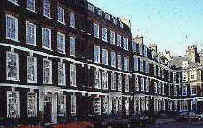LONDON CLOAK AND DAGGER - The spy you save may be your own.
by Jeremy QuistLondon deserves careful examination. This is best done on foot with the occasional help of a double-decker bus or a ride on the underground. So there are dozens of walker's guides to what many feel is the most mannerly large city in the world.
Some guides follow literary footsteps to Sherlock Holmes' Baker Street digs. Others are political and lead to Karl Marx's grave. Cloak and dagger buffs who treasure sneaky British spies, real and literary, now have their own guide, A Spy's London by Roy Berkeley.

No other place, save possibly Zurich during WW II, offers such a history of spies real and imaginary. Fact and fiction can merge too, for example 21 Queen Anne's Gate was for 47 years the official residence and office of the head of M16 (Britain's CIA). Ian Fleming called the chief of service "M"; he was actually called "C", and 21 Queen Anne's Gate was connected to MI6's main office building around the corner by an actual secret passage.
Thames House is home to MI5 (Britain's FBI) before WW II and now again. In the years before WW II, MI5 was so small that its entire staff could (and did) gather for afternoon tea in one room. Today MI5 fills the original building and an addition to its south. Stake out the entrance and you may find yourself the subject of gentle queries from rather fit folks!
However, there's more to the London spy story than buildings. Check out the Pieta statue in the Brompton Oratory in Bromton Road -- don't miss local antique stores either. The statue was a "dead drop" -- a spot to stash secret messages -- by undercover Soviet agents and their case-officer from the Soviet Embassy. You can still touch the exact spot where material was deposited between the right-hand column and the wall behind it.
Some London spots take a more deadly hue. The bus stop on Waterloo Bridge looks innocent enough. It's the site where exiled Bulgarian dissident Georgi Markov was murdered by an agent of the Durzhavna Sigurnost, the KGB-controlled secret police. The murder method was surprisingly mannerly. Perhaps the Bulgarians (who rather specialized in what the Russian's called "wet work") were influenced by the surroundings. More likely the KGB insisted on the use of a tiny ball soaked with Soviet-produced poison called ricin, that was unobtrusively delivered by a jab with the tip of a specially-prepared umbrella.
These are only a few of the spots you'll discover. You can see the WWII home of America's Office of Strategic Services, Soviet mole Guy Burgess's flat, and learn something special about Brown's Hotel, Baker Street, Eaton Square, St. James Square and even Buckingham Palace. You can see where James Bond and John le Carre's George Smiley lived. It's a fine new perspective on a favorite city, carefully organized into 21 walking tours of 136 sites. And the tours each start from an underground station.
